Racing league coverage is soaring thanks to cutting-edge drone technology. You'll experience breathtaking aerial views and immersive first-person perspectives that bring you closer to the action than ever before. Advanced cameras capture smooth, high-speed footage while real-time data integration provides instant stats and analytics. Drones offer cost-effective production solutions, enabling smaller leagues to deliver professional-quality broadcasts. From drone racing leagues to traditional motorsports, aerial coverage is revolutionizing how you watch and engage with races. As regulations evolve and technology advances, the sky's the limit for the future of racing broadcasts.
Rise of Drone Racing Leagues
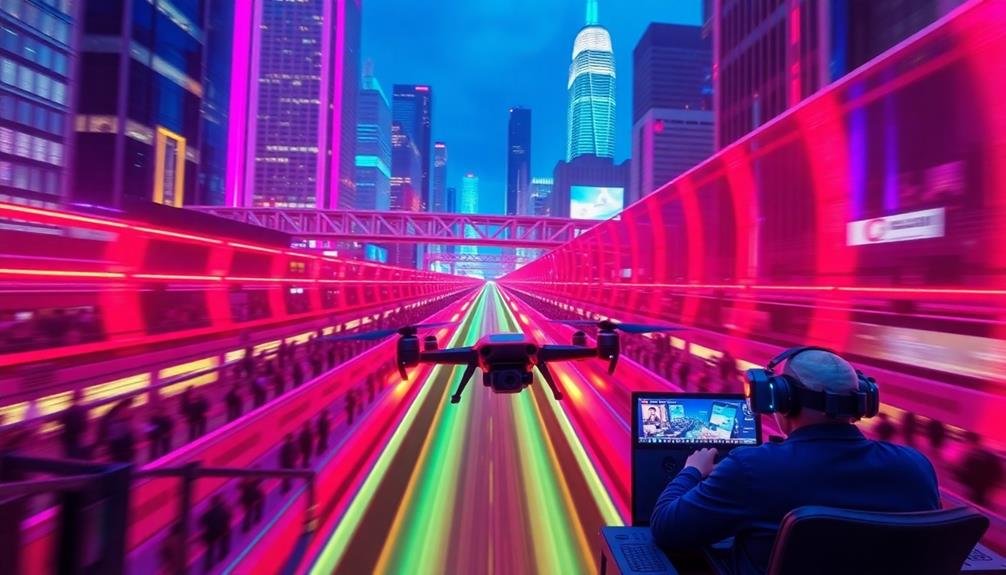
Three key factors have propelled the rise of drone racing leagues in recent years.
First, advancements in drone technology have made these devices more affordable and accessible to enthusiasts. You'll find that today's racing drones are faster, more agile, and easier to control than ever before.
Second, the immersive nature of first-person view (FPV) racing has captivated both pilots and spectators. When you put on those goggles, you're transported into the cockpit, experiencing the thrill of high-speed flight through intricate courses.
Lastly, social media and streaming platforms have played a vital role in popularizing the sport. You can now watch live drone races from anywhere in the world, fostering a global community of fans and aspiring pilots.
As a result, professional leagues like the Drone Racing League (DRL) have emerged, offering substantial prize pools and attracting top talent.
You'll see these leagues partnering with major brands and broadcasters, further legitimizing the sport.
The combination of technological innovation, immersive experiences, and widespread accessibility has positioned drone racing as an exciting new frontier in competitive sports.
Aerial Perspectives Enhance Viewer Experience
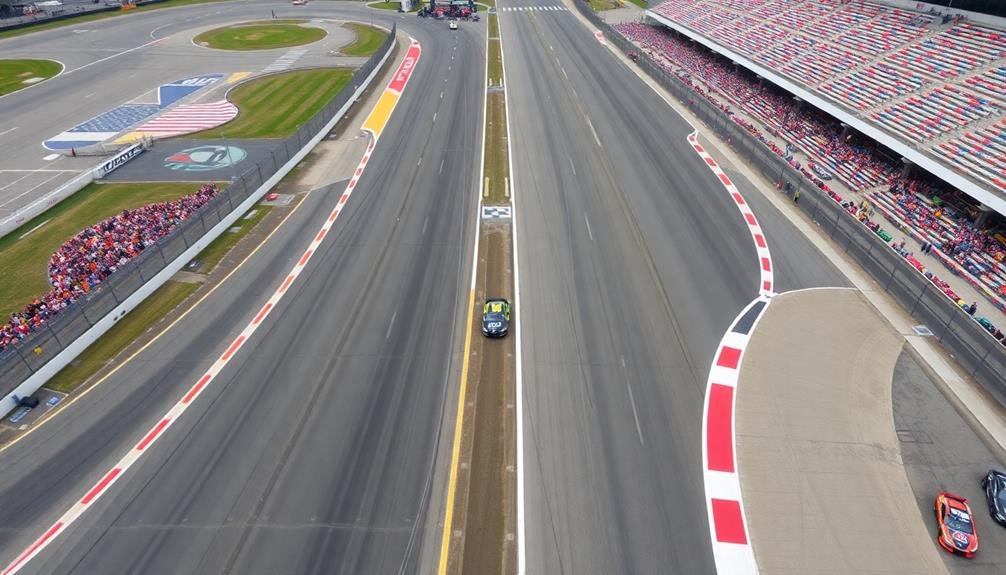
Drone racing's aerial perspectives have revolutionized the viewer experience, offering a unique and thrilling vantage point. You'll feel like you're in the pilot's seat as cameras mounted on racing drones capture high-speed maneuvers through intricate courses.
These bird's-eye views provide an immersive experience that traditional ground-based cameras simply can't match.
As you watch, you'll be amazed by the enhanced visual spectacle:
- First-person view (FPV) feeds let you see exactly what the pilots see
- Dynamic aerial shots showcase the entire race course layout
- Slow-motion replays from multiple angles highlight close calls and precision flying
- Overlay graphics display real-time speed, altitude, and G-force data
The aerial perspective also helps you better understand the skills required for drone racing. You'll witness the split-second decision-making, lightning-fast reflexes, and spatial awareness needed to navigate complex courses at breakneck speeds.
This enhanced viewing experience has played a vital role in drone racing's growing popularity, attracting new fans and keeping existing ones on the edge of their seats.
As technology continues to advance, you can expect even more innovative ways to experience the thrill of drone racing from the comfort of your home.
Technological Advancements in Drone Cameras
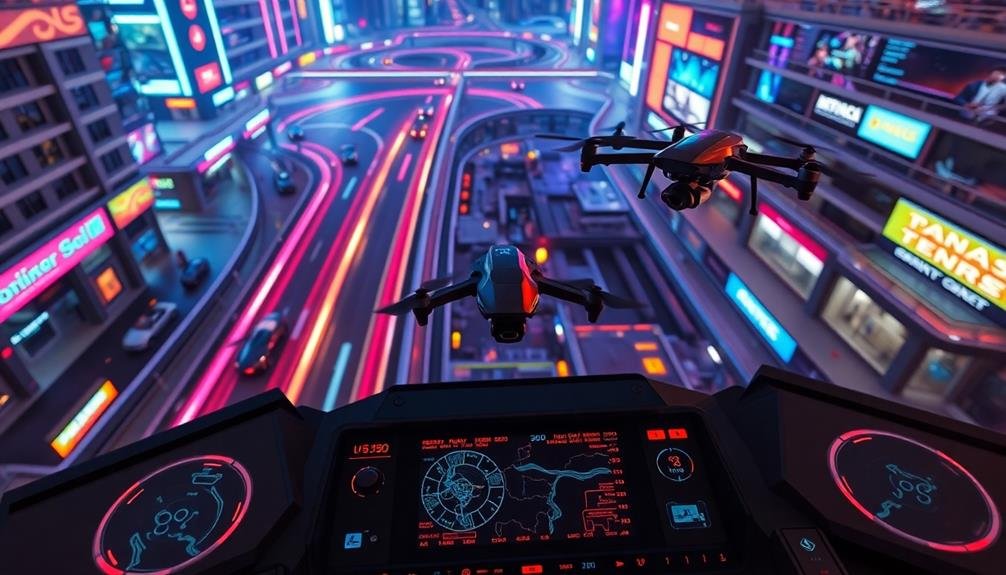
You'll notice a dramatic improvement in racing league coverage thanks to technological advancements in drone cameras.
These cutting-edge drones now offer enhanced aerial perspectives, integrating real-time data to provide you with thorough race information.
Additionally, their advanced obstacle avoidance capabilities guarantee smooth and uninterrupted footage, even in the most challenging racing environments.
Enhanced Aerial Perspectives
Soaring above the racetrack, cutting-edge drone technology has revolutionized aerial coverage in racing leagues. You'll witness breathtaking views and intricate details that were once impossible to capture.
These agile flying cameras offer enhanced aerial perspectives, giving you an immersive experience like never before.
With drones, you'll enjoy:
- Bird's-eye views of the entire circuit
- Dynamic tracking shots following specific racers
- Close-up footage of critical overtaking maneuvers
- Sweeping panoramas showcasing the event's atmosphere
You'll feel like you're right in the middle of the action as drones swoop and glide, capturing every heart-pounding moment. They'll take you to places traditional cameras can't reach, providing unique angles that enhance your understanding of race strategies and vehicle performance.
You'll appreciate the smooth, stabilized footage that modern drones deliver, even in high-speed scenarios.
These aerial marvels can navigate tight spaces and maintain a safe distance from the race, ensuring uninterrupted coverage without compromising safety.
As you watch, you'll gain a deeper appreciation for the skill and precision required in professional racing, all thanks to these enhanced aerial perspectives.
Real-Time Data Integration
As aerial footage captures the race from above, a wealth of real-time data flows seamlessly into the broadcast. You'll notice how drone cameras now integrate telemetry data, GPS positioning, and performance metrics directly into the live feed. This technological leap allows you to see a driver's speed, acceleration, and even G-forces in real-time, enhancing your understanding of the race dynamics.
You'll appreciate how this data integration creates a more immersive viewing experience. As cars navigate tight turns, you can instantly see their exact position on a digital track overlay. When drivers engage in wheel-to-wheel battles, you'll have access to comparative data, showing you precisely how each car is performing.
The integration doesn't stop at vehicle data. You'll also see weather information, tire degradation estimates, and pit stop predictions seamlessly woven into the broadcast.
This thorough approach gives you insights previously reserved for race engineers. By combining stunning aerial visuals with real-time data, racing leagues are revolutionizing how you experience and analyze races, bringing you closer to the action than ever before.
Obstacle Avoidance Capabilities
While drone cameras capture breathtaking aerial footage of racing events, their advanced obstacle avoidance capabilities guarantee seamless and safe operation. You'll be amazed at how these high-tech flying machines navigate complex environments with ease, ensuring uninterrupted coverage of your favorite races.
Modern racing league drones employ sophisticated sensors and algorithms to detect and avoid obstacles in real-time. Here's what makes their obstacle avoidance so impressive:
- LiDAR technology: Emits laser pulses to create 3D maps of surroundings
- Infrared sensors: Detect heat signatures of objects and people
- Ultrasonic sensors: Use sound waves to measure distances to nearby objects
- AI-powered computer vision: Recognizes and classifies obstacles instantly
These technologies work in tandem, allowing drones to react quickly to dynamic racing environments. You'll notice smoother footage as drones effortlessly maneuver around flags, poles, and other potential hazards.
They can even maintain a safe distance from racers and spectators, prioritizing safety without compromising coverage quality.
As obstacle avoidance capabilities continue to improve, you can expect even more immersive and exciting racing league coverage. Drones will venture into tighter spaces and capture previously impossible angles, bringing you closer to the action than ever before.
Real-Time Tracking and Analytics
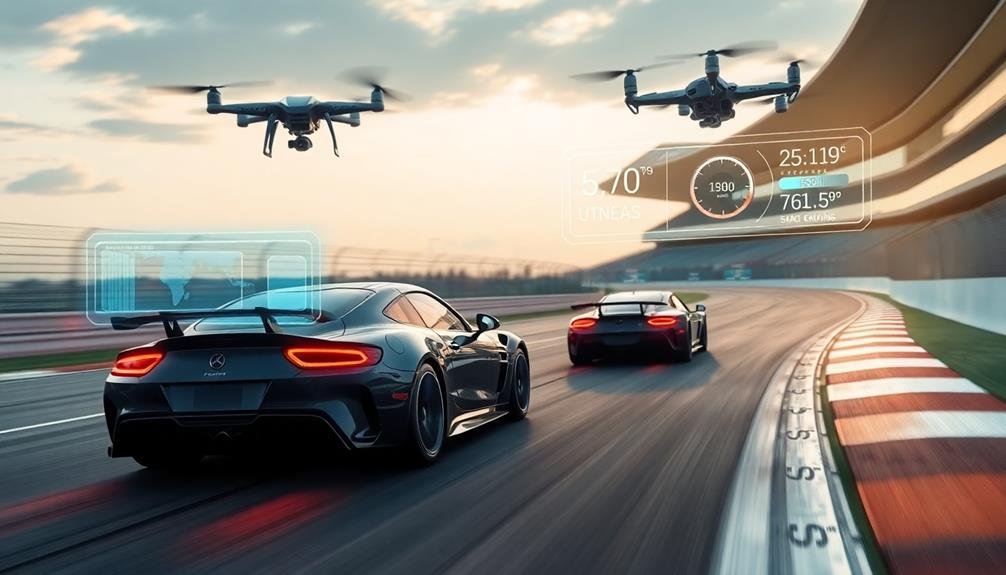
Real-time tracking and analytics have revolutionized racing league coverage. You'll now experience races with unprecedented detail and insight. As drones follow the action, they're equipped with advanced sensors and GPS technology, allowing them to pinpoint each racer's exact location, speed, and trajectory.
This data is instantly transmitted to control centers, where it's processed and visualized for viewers. You'll see live leaderboards, speed comparisons, and projected finish times, all updated in real-time.
The analytics don't stop there – you'll get instant replays from multiple angles, highlighting significant moments and close calls. Machine learning algorithms analyze racing patterns, predicting potential overtakes and strategic moves.
You'll hear commentators using this information to provide deeper insights into race strategies and driver performances. The tracking systems also enhance safety, alerting officials to any irregularities or potential hazards on the track.
For teams and drivers, this wealth of data is invaluable. They use it to fine-tune strategies, improve performance, and make split-second decisions during races.
You're not just watching a race anymore; you're immersed in a data-driven spectacle that brings the thrill of racing to new heights.
Unique Angles for Spectator Engagement
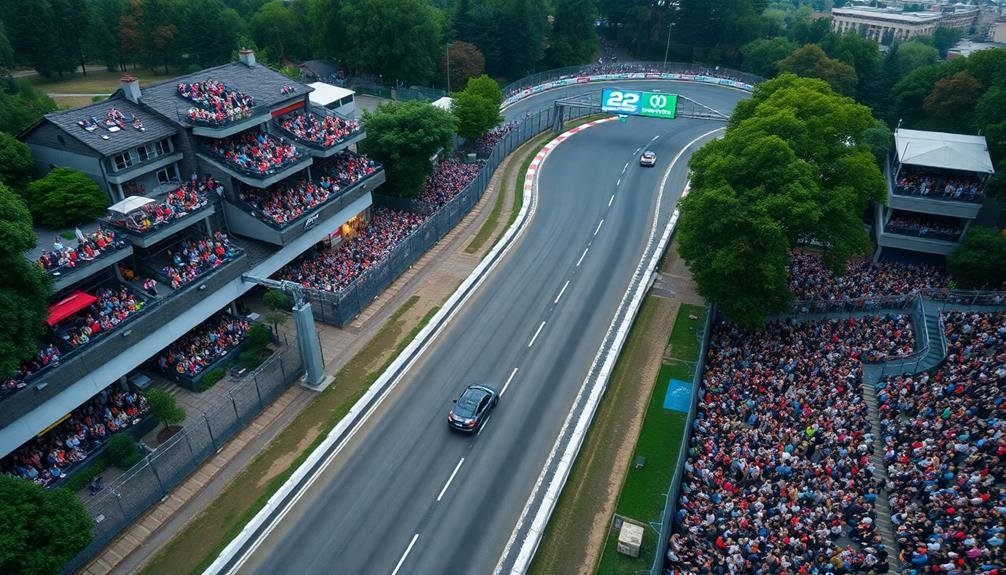
Unique angles for spectator engagement take racing league coverage to the next level. You'll find yourself immersed in the action like never before, thanks to innovative approaches that bring you closer to the track.
Racing leagues are now employing cutting-edge technologies and creative strategies to captivate viewers and enhance their experience.
Here's how they're revolutionizing spectator engagement:
- Drone footage: Get a bird's-eye view of the race, following your favorite drivers from above
- In-car cameras: Experience the race from the driver's perspective, feeling every turn and acceleration
- Virtual reality: Immerse yourself in a 360-degree view of the pit stops and vital moments
- Interactive mobile apps: Customize your viewing experience, access real-time stats, and participate in live polls
These unique angles aren't just about showing you the race; they're about making you feel like you're part of it.
You'll gain insights into driver strategies, team dynamics, and the intricacies of the sport that were previously inaccessible.
Cost-Effective Production Solutions
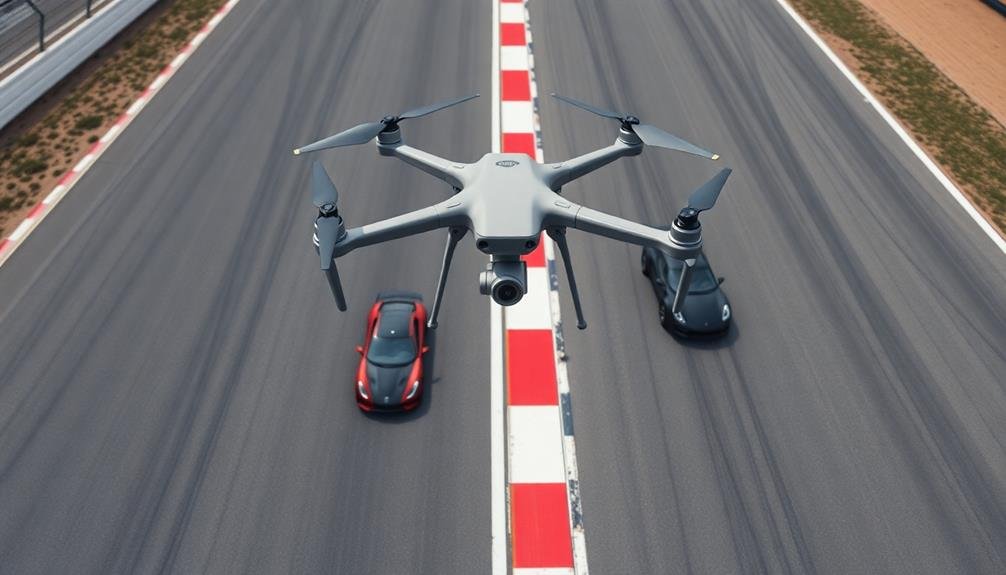
You'll find drone-based camera systems offer a cost-effective way to capture dynamic racing footage while reducing on-site personnel.
Remote production capabilities allow you to streamline operations and minimize travel expenses for your crew.
Drone-Based Camera Systems
Drone-based camera systems have revolutionized racing league coverage by offering a cost-effective alternative to traditional production methods. You'll find these aerial marvels soaring above racetracks, capturing breathtaking angles and dynamic shots that were once impossible or prohibitively expensive to obtain.
With drone technology, you're able to:
- Get up-close and personal with the action without risking camera operators' safety
- Capture smooth, cinematic shots that follow racers through every twist and turn
- Provide viewers with a bird's-eye perspective of the entire track layout
- Quickly reposition cameras to cover unexpected events or highlights
You'll appreciate how drones can access tight spaces and navigate complex environments with ease. They're perfect for showcasing the intricacies of race strategies and the raw speed of the vehicles.
Plus, you'll save considerably on equipment and personnel costs compared to traditional crane or helicopter setups.
As you integrate drone-based systems into your production workflow, you'll discover their versatility in capturing not just races, but also behind-the-scenes content, driver interviews, and promotional material.
This technology isn't just changing how you cover races; it's transforming the entire viewer experience.
Remote Production Capabilities
Remote production setups have transformed racing league coverage, offering a cost-effective solution that doesn't compromise on quality. You'll find that these systems allow broadcasters to cover more races with fewer resources, as they can manage multiple events from a centralized location.
With remote production, you're able to:
| Benefits | Challenges |
|---|---|
| Reduce travel costs | Guarantee reliable connectivity |
| Minimize on-site crew | Manage latency issues |
| Increase event coverage | Coordinate remote teams |
| Streamline workflows | Maintain equipment remotely |
You'll notice that remote production enables faster turnaround times for content creation. By centralizing your production team, you can edit and distribute race footage more efficiently. This approach also allows for greater flexibility in staffing, as you can tap into a wider pool of talent without geographical constraints.
You'll find that remote production setups are particularly advantageous for smaller racing leagues or events. They provide access to high-quality broadcast capabilities without the need for extensive on-site infrastructure. As technology continues to advance, you can expect remote production to become even more seamless and widespread in racing league coverage.
Multi-Purpose Equipment Utilization
Maximizing efficiency in racing league coverage often hinges on the smart use of multi-purpose equipment. You'll find that investing in versatile gear can greatly reduce costs while maintaining high-quality production standards. By choosing equipment that serves multiple functions, you're not only saving money but also streamlining your workflow.
Consider these multi-purpose solutions for your racing league coverage:
- Hybrid cameras that capture both still images and video footage
- Adjustable lighting rigs suitable for various track conditions and times of day
- Modular audio systems adaptable for interviews, commentary, and ambient sound
- Portable workstations capable of editing, streaming, and data analysis
You'll discover that these multi-functional tools can handle diverse tasks across different racing events. They're easy to transport and set up, which is essential when you're covering races at various locations. By utilizing equipment that serves multiple purposes, you're reducing the amount of gear you need to purchase, maintain, and transport.
Additionally, you'll find that multi-purpose equipment often integrates more seamlessly with evolving technologies. This adaptability guarantees that your investment remains relevant as broadcasting standards change, allowing you to stay competitive in the fast-paced world of racing league coverage.
Immersive Storytelling Through Aerial Footage
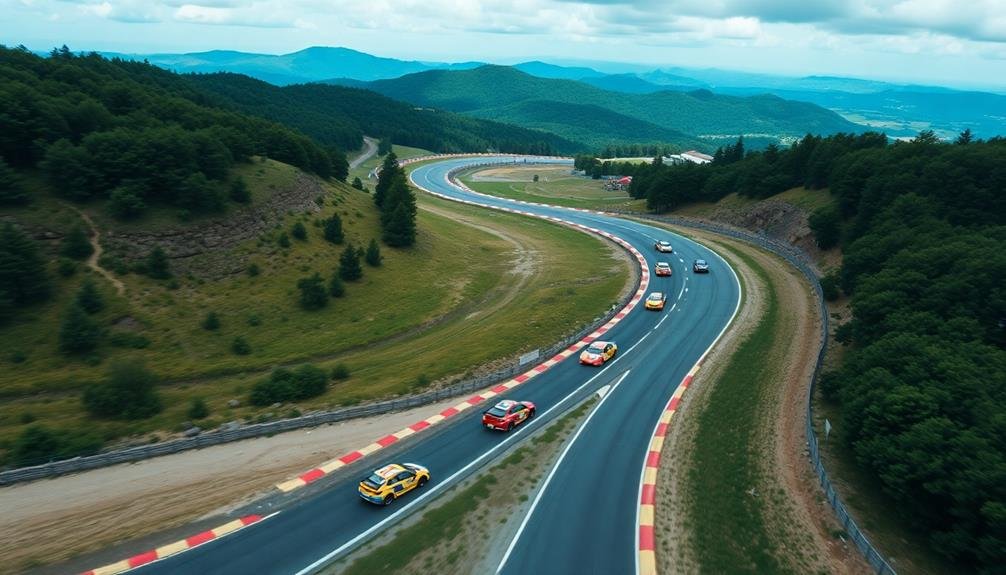
In recent years, aerial footage has revolutionized racing league coverage, offering viewers an unprecedented perspective of the action. You'll find yourself immersed in the heart-pounding excitement as drones and helicopters capture breathtaking views of the racecourse. These aerial shots provide a bird's-eye view of the entire track, allowing you to see the intricate layout and strategic positioning of drivers.
With aerial footage, you'll experience:
| Benefit | Description | Impact |
|---|---|---|
| Panoramic Views | Wide-angle shots of the entire track | Enhanced understanding of race dynamics |
| Strategic Insights | Overhead views of pit stops and driver tactics | Deeper appreciation of team strategies |
| Dramatic Reveals | Sweeping shots of landscapes and crowds | Increased emotional connection to the event |
| Technical Details | Close-ups of car performance and handling | Improved comprehension of vehicle mechanics |
| Real-time Analysis | Integration with data overlays and graphics | More informed viewing experience |
This immersive storytelling approach brings you closer to the action than ever before. You'll gain a deeper understanding of the sport's intricacies, from the drivers' split-second decisions to the team's overall race strategy. As aerial technology continues to advance, you can expect even more enthralling and insightful coverage in the future.
Safety Considerations for Drone Coverage
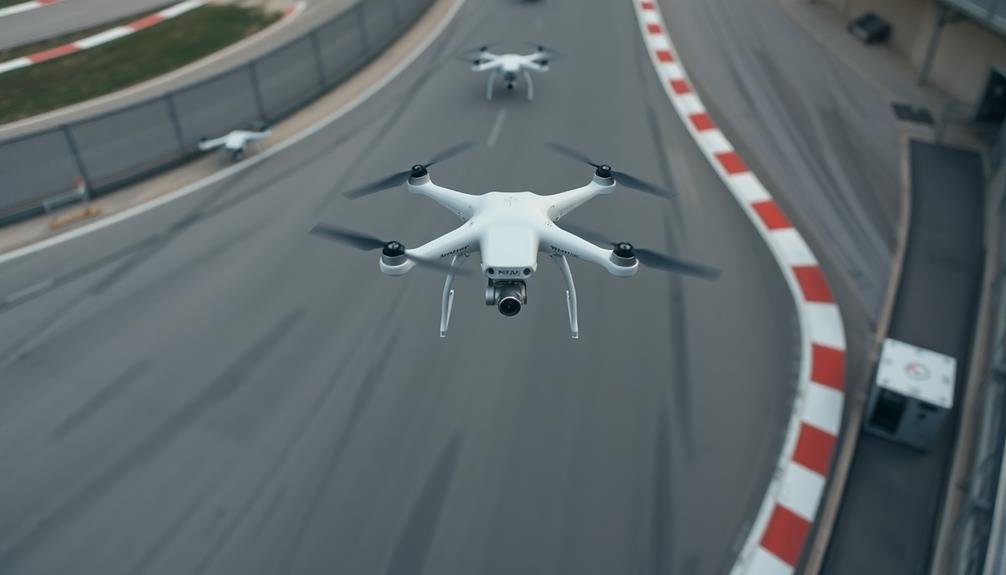
While aerial footage has revolutionized racing coverage, it's important to address the safety considerations that come with drone usage. You'll need to be aware of the potential risks and take necessary precautions to guarantee the safety of everyone involved.
First, you must comply with local regulations and obtain proper licensing for commercial drone operations. This includes understanding airspace restrictions and securing necessary permits.
You'll also need to implement strict safety protocols, including:
- Conducting thorough pre-flight checks
- Maintaining visual line of sight with the drone
- Establishing clear communication channels with race officials
- Setting up designated no-fly zones
You should invest in high-quality equipment with fail-safe features and collision avoidance systems. It's vital to have experienced pilots who can handle unexpected situations and maintain control in challenging conditions.
Weather conditions play a significant role in drone safety. You'll need to monitor wind speeds, visibility, and potential electromagnetic interference that could affect drone performance.
Always have a contingency plan in place for emergencies.
Lastly, you must prioritize the safety of spectators, racers, and crew members. Establish buffer zones between drone flight paths and populated areas, and never fly directly over people or vehicles.
Regulatory Challenges and Opportunities
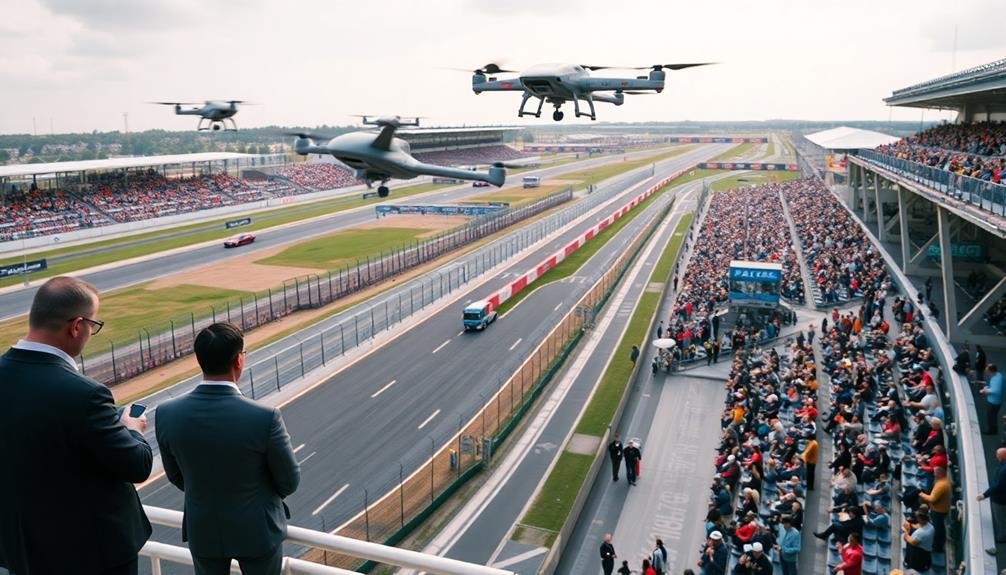
As you navigate the regulatory landscape of drone racing coverage, you'll encounter evolving safety standards that require constant adaptation.
You'll need to stay informed about the latest regulations, which can vary greatly across different regions and countries.
When covering international events, you'll face the additional challenge of coordinating drone operations across borders, necessitating a thorough understanding of each jurisdiction's rules and potential restrictions.
Safety Standards Evolution
Over the years, racing leagues have faced numerous regulatory challenges in their quest to improve safety standards.
You'll notice that these standards have evolved markedly, driven by technological advancements and a growing awareness of the risks involved in high-speed racing.
As you follow racing league coverage, you'll see that safety improvements are constantly being implemented.
These changes affect various aspects of the sport, including:
- Vehicle design and construction
- Driver protective equipment
- Track layout and barriers
- Emergency response protocols
You'll find that modern racing vehicles are engineered with advanced safety features, such as reinforced cockpits and energy-absorbing materials.
Driver suits and helmets have also undergone substantial improvements, offering better protection against impacts and fires.
Track safety has been revolutionized with the introduction of SAFER barriers and improved runoff areas.
You'll also notice enhanced medical facilities and rapid response teams at racing events, ready to provide immediate assistance in case of accidents.
As you continue to watch racing leagues evolve, you'll see that the ongoing commitment to safety not only protects drivers but also enhances the sport's appeal to fans and sponsors alike.
Cross-Border Event Coordination
Racing leagues face unique challenges when organizing events across international borders. You'll find that coordinating cross-border races requires maneuvering through complex regulatory landscapes, each with its own set of rules and requirements.
These challenges include obtaining permits, ensuring compliance with local safety standards, and managing logistics for teams and equipment.
Despite these hurdles, cross-border events offer exciting opportunities for racing leagues. They can expand their audience base, attract new sponsors, and showcase diverse track designs.
You'll see that successful international races often lead to increased global recognition and prestige for the league.
To overcome regulatory challenges, racing leagues must work closely with local authorities and governing bodies. They'll need to establish strong relationships with officials in each country and stay up-to-date on changing regulations.
You'll find that hiring local experts and legal advisors is essential for smooth event coordination.
Technology plays an important role in streamlining cross-border operations. Racing leagues can use specialized software to manage international logistics, track regulatory compliance, and facilitate communication between teams and officials.
Training Drone Pilots for Racing

Dedication and precision are the cornerstones of training drone pilots for racing.
You'll need to develop a unique set of skills to navigate the high-speed, high-stakes world of drone racing. It's not just about flying; it's about mastering complex maneuvers, understanding aerodynamics, and honing your reflexes.
To become a skilled drone racing pilot, you'll focus on:
- Simulator training: Perfecting your technique in a risk-free virtual environment
- Physical drone practice: Translating virtual skills to real-world racing scenarios
- Technical knowledge: Understanding drone components, maintenance, and customization
- Mental preparation: Developing focus, strategy, and stress management techniques
You'll spend countless hours fine-tuning your abilities, starting with basic flight controls and progressing to advanced racing techniques.
As you improve, you'll learn to anticipate obstacles, optimize your racing lines, and push your drone to its limits.
The training process is rigorous, but it's essential for success in this fast-paced sport.
You'll need to stay updated on the latest technology and regulations while continuously challenging yourself to improve.
With dedication and the right training program, you can transform from a novice pilot to a competitive racer ready to take on the world's best.
Post-Production Techniques for Aerial Shots
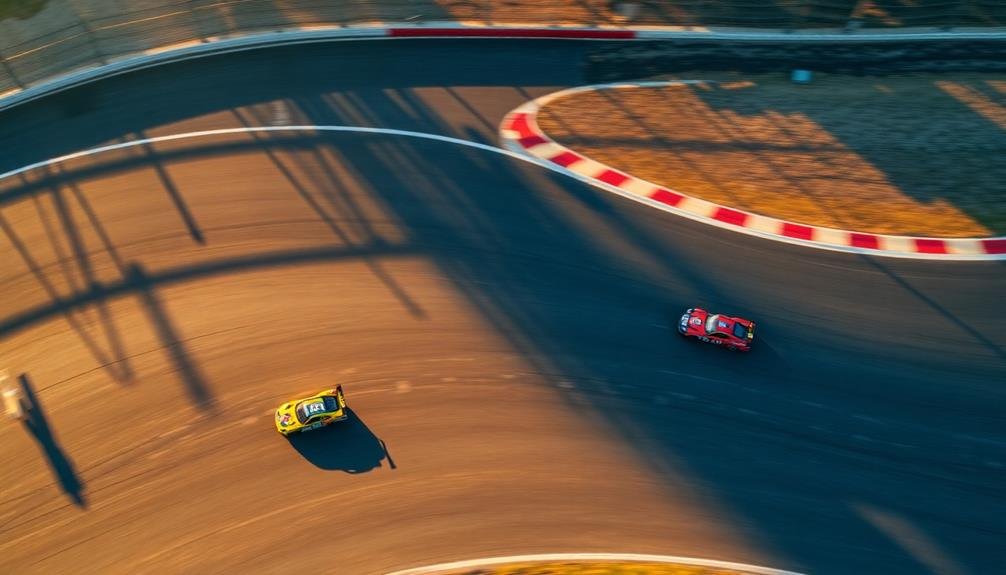
Four key post-production techniques can transform your aerial footage from raw captures to cinematic masterpieces.
First, color grading enhances the visual appeal of your shots. You'll want to adjust the contrast, saturation, and hues to create a cohesive look that matches your racing league's brand identity.
Second, stabilization smooths out any shaky footage, giving your aerial shots a professional, polished appearance. Use software tools to eliminate unwanted camera movements and create fluid shifts.
Third, implement dynamic editing to maintain viewer engagement. Cut between multiple camera angles, including drone footage and ground-level shots, to provide an all-encompassing view of the race. Incorporate slow-motion effects for dramatic moments and use speed ramping to emphasize the intensity of high-speed maneuvers.
Finally, add complementary sound design to enhance the viewing experience. Layer in ambient race sounds, engine noises, and an appropriate music score to create an immersive atmosphere. Don't forget to balance audio levels carefully to guarantee clarity and impact.
Sponsorship Opportunities in Drone Racing
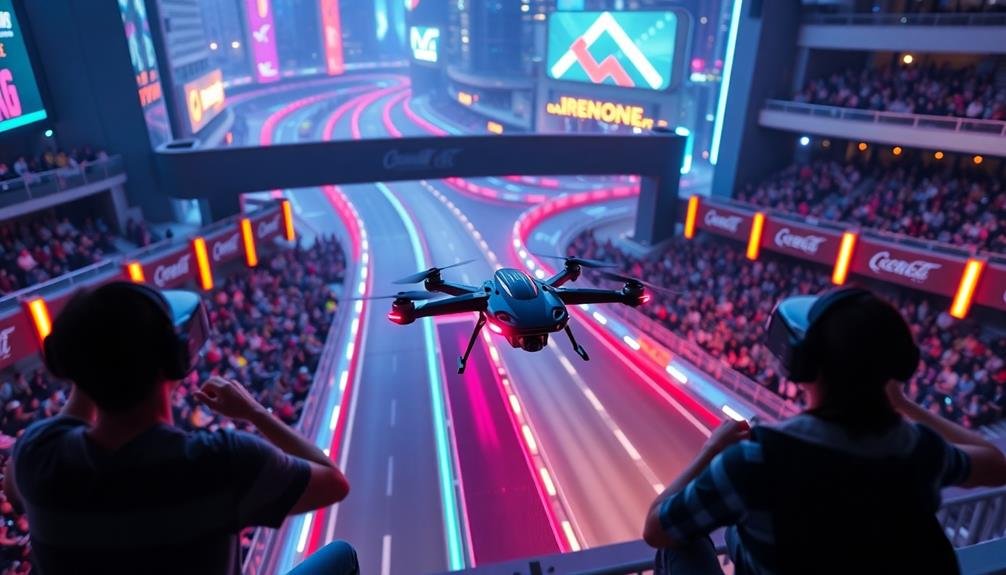
While aerial cinematography enhances the viewer experience, it's the sponsors that fuel the growth of drone racing. You'll find that sponsorship opportunities in this sport are diverse and rapidly expanding. Companies are recognizing the unique demographic drone racing attracts: tech-savvy millennials and Gen Z enthusiasts.
As a potential sponsor, you've got several avenues to explore:
- Drone branding: Your logo prominently displayed on racing drones
- Pilot sponsorships: Supporting individual racers or teams
- Event naming rights: Attaching your brand to major competitions
- Tech partnerships: Providing components or software for the sport
You'll notice that traditional sports sponsorship models are being adapted to fit the high-tech nature of drone racing. It's not just about slapping a logo on a jersey anymore.
You can integrate your products into the very fabric of the sport, from the drones themselves to the VR headsets used by pilots.
Don't overlook the digital opportunities either. With live streaming and social media playing a vital role in drone racing's growth, you'll find plenty of chances for online brand exposure.
The key is to align your brand with the innovation and excitement that define this emerging sport.
Global Expansion of Racing Leagues
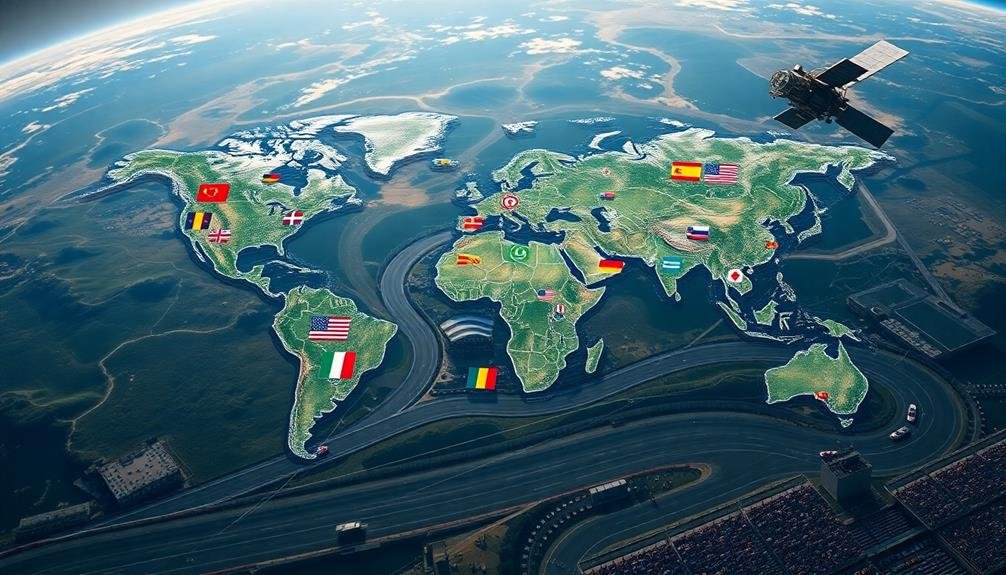
Expanding rapidly across continents, drone racing leagues are taking the world by storm. You'll find these high-speed competitions popping up in major cities worldwide, from New York to Seoul. The Drone Racing League (DRL), a pioneer in the sport, has successfully established events in Europe, Asia, and the Middle East, attracting a diverse global audience.
As you explore this growing phenomenon, you'll notice how different regions are putting their unique spin on drone racing. In Japan, you'll see races integrated with augmented reality elements, while in Australia, you'll find competitions held in stunning natural landscapes. This global expansion isn't just about geography; it's also about cultural integration and adapting to local preferences.
You'll also observe how international collaborations are shaping the sport. Cross-border partnerships between leagues, manufacturers, and media outlets are driving innovation and standardization.
As a result, you're witnessing the emergence of a truly global sport with consistent rules and technologies. This worldwide growth is attracting more sponsors, broadcasters, and investors, further fueling the sport's expansion and cementing its place in the international sports landscape.
Future of Aerial Sports Broadcasting
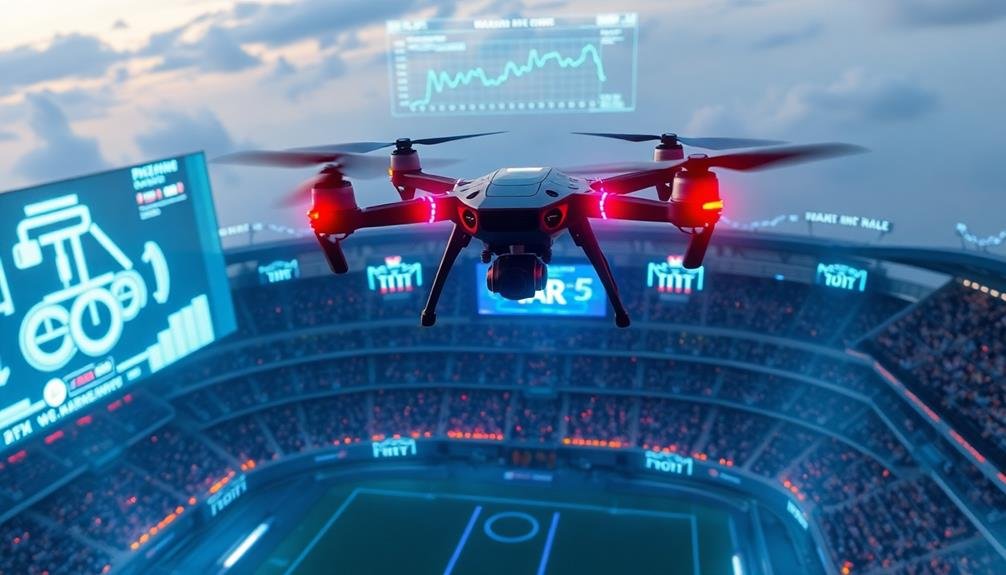
Innovation in aerial sports broadcasting promises to revolutionize how you experience drone racing. As technology advances, you'll witness a transformation in the way these high-speed aerial competitions are captured and presented. Cutting-edge camera drones will offer immersive perspectives, allowing you to feel like you're right in the middle of the action.
The future of aerial sports broadcasting will likely include:
- Real-time 360-degree views, enabling you to control your viewing angle
- AI-powered tracking systems that automatically follow the fastest drones
- Augmented reality overlays providing instant stats and race information
- Virtual reality integration for a fully immersive spectator experience
These advancements will make drone racing more accessible and engaging for viewers worldwide. You'll be able to switch between multiple camera angles, access detailed telemetry data, and even experience the thrill of flying alongside the racers through VR headsets.
As broadcasting technology continues to evolve, you can expect higher-quality live streams, reduced latency, and enhanced graphics that bring the excitement of aerial sports directly to your living room or mobile device.
Frequently Asked Questions
How Do Drone Racing Leagues Recruit and Select Their Pilots?
You'll find drone racing leagues recruit pilots through various channels. They hold open tryouts, scout online leaderboards, and monitor social media for talented flyers. Selection often involves skill tests, competitions, and evaluating a pilot's online following and marketability.
What Insurance Considerations Are Involved in Drone Racing Events?
You'll need to contemplate liability insurance for pilots, spectators, and property damage. Event organizers must secure coverage for accidents, equipment failures, and potential injuries. Don't forget drone-specific policies to protect against crashes and malfunctions.
How Do Weather Conditions Affect Drone Racing Competitions?
You'll find weather conditions greatly impact drone racing. Wind can throw off your drone's stability, while rain or snow interferes with visibility and electronics. Temperature extremes affect battery performance. You'll need to adapt your flying style accordingly.
Are There Age Restrictions for Participating in Professional Drone Racing Leagues?
You'll find age restrictions vary among professional drone racing leagues. Most require participants to be at least 16-18 years old. Some leagues have junior divisions for younger racers, but you'll need parental consent if you're underage.
How Do Drone Racing Leagues Handle Disputes or Protests During Races?
You'll find that drone racing leagues typically have officials who monitor races closely. They'll review footage and telemetry data to resolve disputes. If you protest a race result, you'll need to follow the league's specific procedures for filing complaints.
In Summary
You're witnessing a revolution in sports broadcasting. Drone racing leagues are soaring, offering you unprecedented views and thrilling experiences. With cutting-edge technology, you'll enjoy real-time tracking and unique angles that'll keep you on the edge of your seat. As these leagues expand globally, you'll see more sponsorship opportunities and innovative post-production techniques. Get ready for an exciting future in aerial sports coverage – it's taking off, and you won't want to miss it.

As educators and advocates for responsible drone use, we’re committed to sharing our knowledge and expertise with aspiring aerial photographers.




Leave a Reply